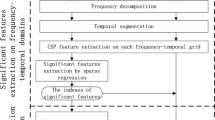Abstract
Common spatial pattern (CSP) algorithm and principal component analysis (PCA) are two commonly used key techniques for EEG component selection and EEG feature extraction for EEG-based brain-computer interfaces (BCIs). However, both the ordinary CSP and PCA algorithms face a loading problem, i.e., their weights in linear combinations are non-zero. This problem makes a BCI system easy to be over-fitted during training process, because not all of the information from EEG data are relevant to the given tasks. To deal with the loading problem, this paper proposes a spare CSP algorithm and introduces a sparse PCA algorithm to BCIs. The performance of BCIs using the proposed sparse CSP and sparse PCA techniques is evaluated on a motor imagery classification task and a vigilance estimation task. Experimental results demonstrate that the BCI system with sparse PCA and sparse CSP techniques are superior to that using the ordinary PCA and CSP algorithms.
Access this chapter
Tax calculation will be finalised at checkout
Purchases are for personal use only
Preview
Unable to display preview. Download preview PDF.
Similar content being viewed by others
References
Lotte, F., Congedo, M., Lecuyer, A., Lamarche, F., Arnaldi, F.: A review of classification algorithms for EEG-based brain-computer interfaces. Journal of Neural Engineering 4, R1–R13 (2007)
Brunner, P., Bianchi, L., Guger, C., Schalk, G.: Current trends in hardware and software for brain-computer interfaces. Journal of Neural Engineering 8(2) (in press, 2011)
Koles, Z.: The quantitative extraction and topographic mapping of the abnormal components in the clinical EEG. Electroencephalogr. Clin. Neurophysiol. 79(6), 440–447 (1997)
Zou, H., Hastie, T., Tibshirani, R.: Sparse principal component analysis. Journal of Computational and Graphical Statistics 15(2), 265–286 (2006)
BCI Competition III, http://www.bbci.de/competition/iii/
Efron, B., Hastie, T., Johnstone, I., Tibshirani, R.: Least angel regression. Annals of Statistics 32(2), 407–499 (2004)
Zou, H., Hastie, T.: Regularization and variable selection via the elastic net. Journal of the Royal Statistical Society: Series B 67(2), 301–320 (2005)
Shi, L.C., Lu, B.L.: Dynamic clustering for vigilance analysis based on EEG. In: Proce. of the 30th International Conference of the IEEE Engineering in Medicine and Biology Society, Vancouver, Canada, pp. 54–57 (2008)
Shi, L.C., Lu, B.L.: Off-Line and On-Line Vigilance Estimation Based on Linear Dynamical System and Manifold Learning. In: Proce. of the 32nd International Conference of the IEEE Engineering in Medicine and Biology Society, Buenos Aires, Argentina, pp. 6587–6590 (2010)
Ma, J.X., Shi, L.C., Lu, B.L.: Vigilance estimation by using electrooculographic features. In: Proce. of the 32nd International Conference of the IEEE Engineering in Medicine and Biology Society, Buenos Aires, Argentina, pp. 6591–6594 (2010)
Lee, D.D., Seung, H.S.: Learning the parts of objects by non-negative matrix factorization. Nature 401, 788–791 (1999)
Author information
Authors and Affiliations
Editor information
Editors and Affiliations
Rights and permissions
Copyright information
© 2011 Springer-Verlag Berlin Heidelberg
About this paper
Cite this paper
Shi, LC., Li, Y., Sun, RH., Lu, BL. (2011). A Sparse Common Spatial Pattern Algorithm for Brain-Computer Interface. In: Lu, BL., Zhang, L., Kwok, J. (eds) Neural Information Processing. ICONIP 2011. Lecture Notes in Computer Science, vol 7062. Springer, Berlin, Heidelberg. https://doi.org/10.1007/978-3-642-24955-6_86
Download citation
DOI: https://doi.org/10.1007/978-3-642-24955-6_86
Publisher Name: Springer, Berlin, Heidelberg
Print ISBN: 978-3-642-24954-9
Online ISBN: 978-3-642-24955-6
eBook Packages: Computer ScienceComputer Science (R0)




